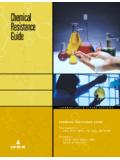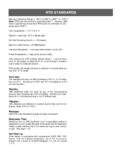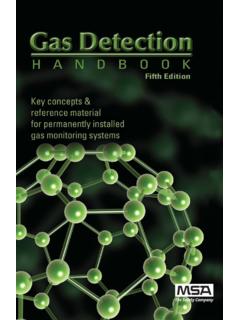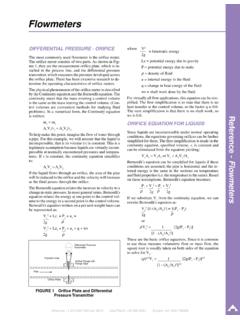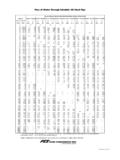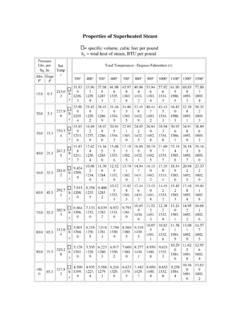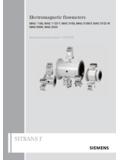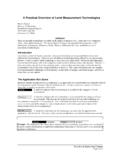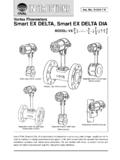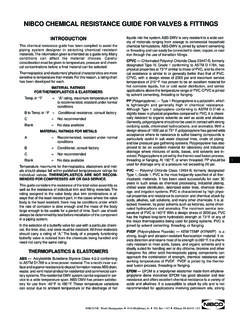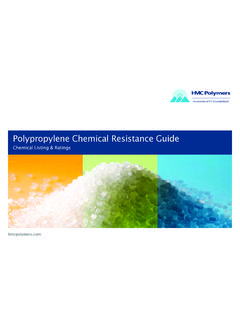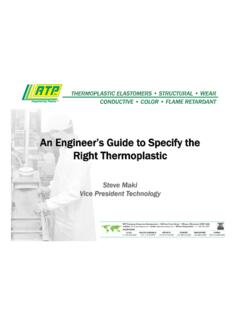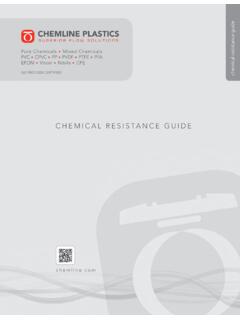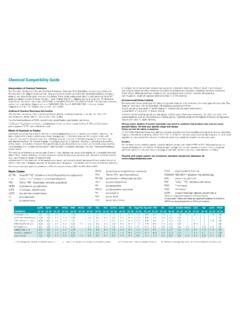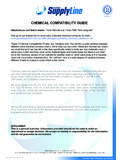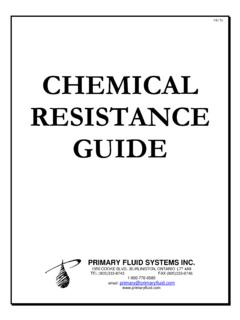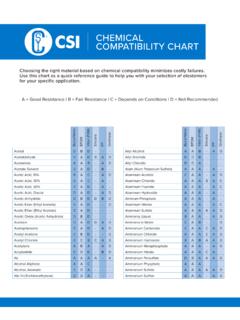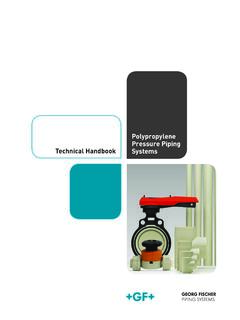Transcription of Chemical Resistance Guide - Gilson Eng
1 THERMOPLASTIC PIPING SYSTEMSCHEMICAL Resistance GUIDET hermoplastics:ABS, PVC, CPVC, PE, PEX, PP, PVDFE lastomers:EPDM, FPM (FKM), SBR,BUNA-N (Nitrile)ChemicalResistanceGuideSEARCHSE ARCH THIS Chemical Resistance GUIDE1 INTRODUCTIONT hermoplastics and elastomers have outstanding Resistance to a wide range of Chemical reagents. The Chemical resistanceof plastic piping is basically a function of the thermoplastic material and the compounding components. In general, the lesscompounding components used the better the Chemical Resistance . Thermoplastic pipes with significant filler percentagesmay be susceptible to Chemical attack where an unfilled material may be affected to a lesser degree or not at newer piping products utilize a multi-layered (composite) construction. Both thermoplastic and non-thermoplasticmaterials are used for the layers. Layered composite material pipe may have Chemical Resistance that differs from the chemicalresistance of the individual material.
2 Such Resistance however, is a function both of temperatures and concentration, andthere are many reagents which can be handled for limited temperature ranges and concentrations. In borderline cases, it willbe found that there is limited attack, generally resulting in some swelling due to absorption. There are also many cases wheresome attack will occur under specific conditions, but for many such applications, the use of plastic will be justified oneconomic grounds when considered against alternative materials. Resistance is often affected (and frequently reduced) whenhandling a number of chemicals or compounds containing impurities. For this reason, when specific applications are beingconsidered, it may be worthwhile to carry out tests using the actual product that will be encountered in service. The listingthat follows does not address Chemical data in the following tables were obtained from numerous sources in the industry.
3 The information is based on immersiontests on unstressed coupons, experiments and, when available, actual process experience as well as data from tests inclusiveof stress from temperature and pressure. The end user should be aware of the fact that actual service conditions will affect thechemical that do not normally affect the properties of an unstressed thermoplastic may cause completely different behavior (such as stress cracking) when under thermal or mechanical stress (such as constant internal pressure or frequentthermal or mechanical stress cycles). Chemical Resistance data from immersion tests cannot be unconditionally applied tothermoplastic piping components subjected to continuous or frequent mechanical or thermal the pipe will be subject to a continuous applied mechanical or thermal stress or to combinations of chemicals, testingthat duplicates the expected field conditions as closely as possible should be performed on representative samples of thepipe product to properly evaluate plastic pipe for use in this Resistance - All materials belonging to this class are completely or almost completely inert when used with thespecified Chemical at the specified concentration/temperature Resistance - All materials belonging in this class are partially attacked by the specified chemicals at the specified concentration/temperature levels.
4 Life expectancy is thus shortened and it is recommended to use a highersafety factor than that adopted for Class 1 Resistance - All materials in this class are severely attacked by the specified chemicals at the specified concentration/temperature levels. They should, therefore, not be absence of any class indication for any given materials, signifies the absence of data for such material(s) with respectto the specific Chemical (s), temperature(s) and concentration(s). Chemical Resistance GUIDE2 THERMOPLASTICS ABS- (Acrylonitrile-Butadiene-Styrene) is ideal for residential and commercial sanitary (DWV) systems. With a workingpressure up to 230 psi, ABS is also suitable for industrial applications such as mine slurry lines. Temperature range is -40 C(-40 F) to 82 C (180 F). ABS is resistant to a wide variety of materials ranging from sewage to household chemicals. It isjoined by solvent cementing or (Polyvinyl Chloride) is the most frequently specified of all thermoplastic-piping materials.
5 It has been used success-fully for over 60 years. PVC is characterized by distinctive physical properties, and is resistant to corrosion and chemicalattack by acids, alkalis, salt solutions and many other chemicals. It is attacked, however by polar solvents such as ketonesand aromatics. Of the various types and grades of PVC used in plastic piping, Type 1, Grade 1 PVC (Cell Classifications 12454)conforming to ASTM D1784, is the most common. The maximum service temperature for PVC is 60 C (140 F) underpressure and 82 C (180 F) in drainage. With a design stress of 2,000 psi, PVC has the highest long-term hydrostatic C (73 F) of any other major thermoplastic material used for piping. PVC piping is joined by solvent cementing, thread-ing, flanging, grooving, gasketed joints, or mechanical (Chlorinated PVC) (Cell Classification 23447), conforming to ASTM D 1784 has physical properties at C (73 F)similar to those of PVC; its Chemical Resistance is similar to or generally better than that of PVC.
6 With a design stress of 2,000psi and maximum service temperature of C (200 F), CPVC has proven to be an excellent piping material for hot corro-sive liquids, hot and cold water distribution and similar applications above the temperature range of PVC. CPVC piping isjoined by solvent cementing, threading, flanging or grooved (Polyethylene) is a member of the polyolefin group. It is tough and flexible even at subfreezing temperatures. Pipes aregenerally formulated with only an antioxidant and some pigments, usually carbon black, to screen out ultraviolet D 1248 classifies three types. Type I low density, Type II medium density and Type III high density. Pipe is usually madefrom medium or high density for higher strength and hardness. PE is generally used for gas distribution, water lines andslurry (Cross-linked Polyethylene) is high density PE that undergoes a treatment to link single strands of PE through radicalreactions between the molecules to form a dense network with up to 80% crosslinking.
7 The primary reason to crosslink PEis to raise the thermal stability of the material. Service temperatures are raised to 82 C (180 F). PEX pipe is primarily usedfor plumbing and radiant floor heating (Polypropylene) is a lightweight polyolefin and generally high in Chemical Resistance . Although Type 1 polypropyleneconforming to ASTM D2146 is slightly lower in physical properties than PVC, it is chemically resistant to organic solvents aswell as acids and alkalis. Generally, polypropylene should not be used in contact with strong oxidizing acids, chlorinatedhydrocarbons and aromatics. Polypropylene has a design stress of 1,000 psi at C (73 F), and has proven to be an excel-lent material for laboratory and industrial drainage pipe where mixtures of acids, bases and solvents are is joined by the electro fusion process, socket/butt/IR welding as well as mechanical (Polyvinylidene Fluoride) is a strong, abrasion-resistant thermoplastic with excellent heat stability and chemicalresistance typical of fluorocarbon polymers.
8 It can be used in temperatures up to 149 C (300 F) with a wide variety of acids,bases and organic solvents, and is ideally suited for handling wet or dry chlorine, bromine and other halogens. No otherthermoplastic piping material can approach the combination of strength, Chemical Resistance and operating temperature thatPVDF piping systems can offer. Electro fusion socket/butt/IR welding, threading, or flanged connections are the joiningmethods used for TO Chemical Resistance GUIDEELASTOMERSBUNA-N- (Nitrile) (NBR) is a general purpose oil resistant polymer known as nitrile rubber. BUNA-N is a copolymer of butadi-ene and acrylonitrile. BUNA-N has good solvent, oil, water and hydraulic fluid Resistance . It displays good compression set,abrasion Resistance and tensile strength. BUNA-N should not be used in highly polar solvents such as acetone and methylethyl ketone, nor should it be used in chlorinated hydrocarbons, ozone or nitro hydrocarbons.
9 Temperature range -54 C(-65 F) to 135 C (275 F).EPDM- (EPM) is an elastomer made from ethylene-propylene diene monomer. EPDM has good abrasion and tear resistanceand offers excellent Chemical Resistance to a variety of acids and alkalines. It is susceptible to attack by oils and is not recom-mended for applications involving petroleum oils, strong acids or strong alkalines. It has exceptionally good weather, ageingand ozone Resistance . It is fairly good with ketones and alcohols and has an excellent temperature range from -54 C (-65 F)to 49 C (300 F).Fluorocarbon- (FPM) (FKM) (Viton ) Fluorocarbon elastomers are inherently compatible with a broad spectrum of chemi-cals. Because of this extensive Chemical compatibility, which spans considerable concentration and temperature ranges,fluorocarbon elastomers have gained wide acceptance as a material of construction for butterfly valve o-rings and elastomers can be used in most applications involving mineral acids, salt solutions, chlorinated hydrocarbons,and petroleum oils.
10 They are particularly good in hydrocarbon service. Temperature range -29 C (-15 F) to 204 C (400 F).SBR- (Styrene-Butadiene) The basic monomers are butadiene and styrene, with styrene content approximately It isuseful over a temperature range of -57 C (-70 F) to 107 C (224 F). It is compatible with water, alcohol, and weak acids butis not compatible with mineral oils, petroleum greases and - (PTFE) Polytetrafluoroethylene has outstanding Resistance to Chemical attack by most chemicals and solvents. PTFEhas a temperature rating of -29 C ( -20 F) to 204 C (400 F) in valve applications. PTFE, a self lubricating compound, is usedas a seat material in ball valves. PTFE is not included in this chart because it is resistant to all listed TO Chemical Resistance GUIDE3 Viton is a registered trademark of DuPont Dow Resistance CHART4 PVCCPVCPPPVDFABSC hemicals1 - High Resistance 2 - Limited Resistance 3 - No Resistance Temp.
